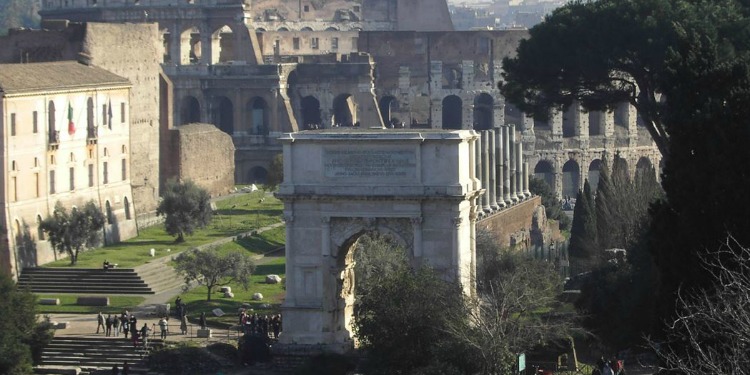Celebrating History’s Reversal in Rome
The Fellowship | May 30, 2018

My husband and I took the trip to Rome this spring in honor of his birthday. I had searched for a place with rich Jewish history, one of my husband’s great passions, and also good kosher food. Rome fit the bill and, with its short three-hour flight from Israel, made for the perfect quick getaway.
The first thing we saw when we arrived at our hotel in Rome was a fountain. Rome is filled with fountains, but this one in particular, as we would later learn, has a special link to Rome’s Jewish community. For over 300 years, beginning in 1555, the Jews of Rome were forced to live in the confines of the Roman Jewish Ghetto, a small, walled-in, decrepit area that flooded often. The fountain was the ghetto’s source of fresh water.
In 1659, the fountain was refurbished by the famous sculptor Bernini, who added turtles to the design. According to our tour guide, the turtles symbolized the Jews – exiled from their land, the Jews carried their homes on their backs, bringing their traditions and values with them wherever they went.
I felt at home in Rome almost immediately. Part of Rome reminded me of New York, where I spent my childhood, and part of Rome reminded me of Jerusalem, just outside of which I live now. Many of the ancient ruins in Rome parallel ancient Roman ruins in Jerusalem. The olive trees, the pomegranate trees, the jasmine climbing the buildings, the cobblestone roads, and the Mediterranean diet all reminded me of home. But perhaps it was the presence of Jews in Rome for over 2,000 years that made me feel so connected to this city. In many ways, Rome picked up the story of the Jews where Jerusalem left off.
In 70 C.E., the Romans destroyed the Temple, officially ending any hopes of Jewish sovereignty in Jerusalem. Though many would continue to fight for Jerusalem throughout the millennium, about 100,000 Jews ended up in Rome and spread to the four corners of the earth from there. Some of those Jews have remained in Rome ever since.
In Israel, I regularly bear witness to our ancient past and to the wondrous future unfolding before our eyes. In Rome, I saw the beginnings of our 2,000-year exile, the bitter years that separate our past and our present.
And nothing better captures the tragic capture of Jerusalem than the infamous Arch of Titus. Located near the Coliseum (which, incidentally, was built with funds from the plunder of Jerusalem and most likely built in part by Jewish slave labor), the Arch of Titus is a structure dedicated to the Roman general Titus and his victory over Jerusalem, including the destruction of the Holy Temple. This famous arch erected around 80 C.E. shows the Romans triumphantly carrying off the menorah (lampstand), the showbread table, and ritual trumpets from the Holy Temple. These holy vessels have been gone from the Jewish people ever since.
Our Jewish tour guide revealed to us that the chief rabbi of Rome forbade anyone in the Jewish community to pass through the Arch of Titus, as walking through the arch is an act that attributes honor to Titus, the destroyer of Jerusalem. For thousands of years, this custom was kept by the Jewish residents of Rome – until December 2, 1947.
On November 29, 1947, the United Nations voted to give the Jews a country of their own in their ancient homeland. The dream of Israel was to become a reality. A few days later, the chief rabbi of Rome instructed the people that it was time to walk under the Arch of Titus, however they would not pass through moving forward, but rather they would walk backwards. This symbolic act, recognizing the return of the Jews to Jerusalem, demonstrated that the Jews were going back – back to how things were before Titus conquered Jerusalem, back to times when Jews had sovereignty in their own land, back to the land of Israel. The destruction Titus had caused was beginning to come undone. History would reverse itself.
When my husband and I planned our trip, we had no idea that it would coincide with the historic move of the American Embassy to Jerusalem. But as we encountered the Arch of Titus, it was at the very same time that the inauguration of the embassy was taking place.
What a profound moment that was. As we bore witness to the loss of Jerusalem, we celebrated the beginning of international recognition of Jerusalem as the eternal capital of the Jewish people.
After the Romans captured Jerusalem, they issued a special coin depicting a Jew weeping under a tree with the words “Judea Captiva,” “Judea is captured,” written on it. Well, those days are over. Today, the Jews of Israel are free, Jerusalem is liberated, and Israel is our homeland once again.
Our last night in Rome, we strolled along the streets of what was once the Jewish ghetto, enjoyed the relaxed atmosphere, and the kosher restaurants treating tourists to Jewish Roman cuisine. A few hours later we boarded our flight back to Israel. As we landed at Ben Gurion Airport, my heart was full of joy. Our vacation had been wonderful, but there is no place like home.
Yonit Rotchild is The Fellowship‘s senior writer in Israel.
